|
Messerschmitt Bf 110 E
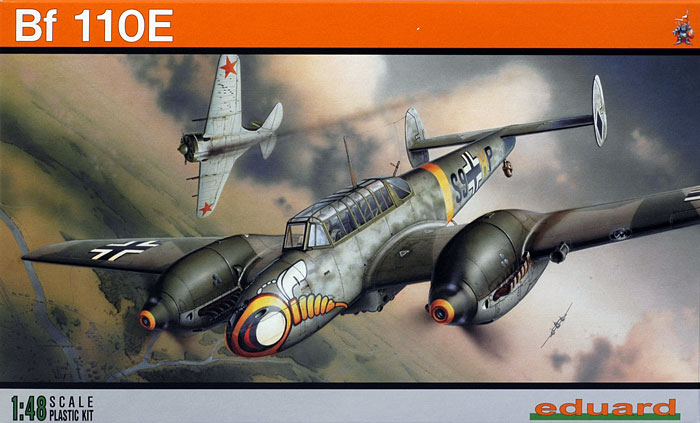
Eduard, 1/48 scale
S
u m m a r y
|
| Catalogue Number: |
Eduard Kit No. 8203 - Messerschmitt
Bf 110 E |
| Scale: |
1/48 |
| Contents and Media: |
314 parts in olive coloured plastic;
12 parts in clear; two parts in brown resin; colour photo-etched fret; masking sheet; markings for
five aircraft. |
| Price: |
Will be available
for USD$49.95 plus shipping online from Eduard
from 1 September
Will also be available in limited
quantities at the IPMS USA Nationals, Anaheim California |
| Review Type: |
FirstLook |
| Advantages: |
Well detailed; superb surface
features including crisply recessed panels and subtle rivet lines where
appropriate; includes colour photo-etched parts for harnesses and
instrument panel; separate canopy parts for closed/open cockpit and rear
clamshell; attractive marking options; very high quality
plastic; narrow sprue attachments; lots of options (including many marked not for use
in this kit which would permit a Bf 110 C or D); dachshunds are
included. |
| Disadvantages: |
|
| Recommendation: |
Highly Recommended |
Reviewed by Brett Green

Eduard's 1/48 scale Messerschmitt Bf 110 E will be
available online from Squadron.com
The Messerschmitt Bf 110 entered the Second World War as a new and
prestigious weapon of the Luftwaffe, performing the roles of
bomber escort, heavy fighter and troop support during the German
invasion of Poland. It performed well against Polish fighters, and put
its heavy armament to effective use against ground targets after the
Luftwaffe had established air superiority. The Bf 110 repeated these
roles during the campaign in the West. The long range of the Bf 110 was
especially useful for escorting bombers deep into France.
The twin engine Messerschmitt was more than a match for most
contemporary French fighters, but early encounters with Spitfires and
Hurricanes resulted in unaccustomedly heavy losses. This was an ominous
indicator of the coming months over the British Isles.
In those Summer months of 1940, Messerschmitt Bf 110s on long-range
escort missions suffered heavy losses to British fighters. Eventually,
Messerschmitt Bf 110s had to be escorted themselves by the more nimble
Bf 109s.
Even if its fortunes as a pure fighter aircraft were mixed, the
Messerschmitt Bf 110 had a better record as a defensive weapon.
As early as December 1939, Bf 110 C aircraft of I./ZG 76 were
involved in the decimation of an armed reconnaissance patrol over the
Heligoland Bight. Eight Wellingtons out of a total 22 on patrol were
claimed by the Zerstörers. This single event put massed daylight
bombing off the agenda until 1943, but ZG 2 and ZG 76 continued to enjoy
superiority over Blenheims and Wellingtons in the following months.
Arguably the most important contribution made to the German war
effort by the Messerschmitt Bf 110 was as a night fighter. The role was
initially ad-hoc. From July, 1940, day fighters were simply painted
black and sent aloft to deal with British bombers, now making their
attacks under the relative protection of darkness. These early night
fighters had no additional equipment nor ground control assistance.
Enemy aircraft were held in the cone of a searchlight, and the Bf 110
would engage the bomber while it was illuminated in the beam.
The subject of Eduard's kit, the Messerschmitt Bf 110 E, was a
refinement of the C and D models, beginning production in August 1940.
The Bf 110 E was a versatile long distance bomber and heavy fighter. In
addition to its ordnance and new gunsight, revisions were also made to
the rear machine gun, and inside the cockpit. The most obvious exterior
change was the addition of a rectangular air intake on the front of the
top gun cowl.
Eduard's box art is always attractive, but this one is my favourite to
date. The illustration depicts a Zerstörer of II./ZG 1 finished
in RLM 02 Grey and 71 Dark Green with the striking Wespen nose in
combat over the Eastern Front.
Under the evocative box art, Eduard's 1/48 scale
Messerschmitt Bf 110 E comprises a staggering 314 parts in olive
coloured plastic; 12 parts in clear; two parts in brown resin; one
colour photo-etched fret and another fret in bare metal; a masking sheet
and markings for five aircraft.
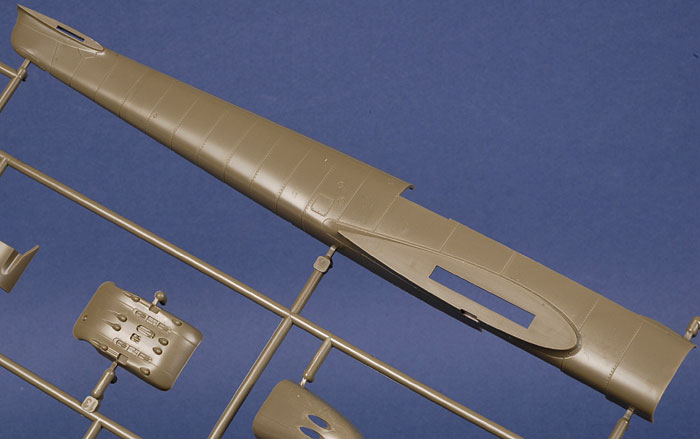
Click
the thumbnails below to view larger images:
[../../../photogallery/photo00010723/real.htm]
This latest release continues Eduard's recent tradition of world
class quality
injection moulded parts, remarkable detail and colorful markings.
The styrene parts are attached to seven sprues via fine connectors.
Moulding quality is superb. I could not find a single sink mark or
ejector pin in any area that will be visible on the finished model.
If you have seen the beautifully restrained surface detail of
Eduard's recent Fw 190 family, you will know what to expect here.
Crisply recessed panel lines are partnered with incredibly subtle rows
of rivets. I like the treatment of the fabric control surfaces too, with
rib tape detail being the most prominent feature - no massive sagging of
fabric.
The fuselage is broken down into the main halves with a separate nose
(upper and lower) plus an insert for the deck immediately aft of the
cockpit. The tail is moulded as a single piece so if we are going to
eventually see a boat tail version, Eduard will supply an all new
fuselage. In addition to the Bf 110 E nose (easily distinguished by the
rectangular intake), Eduard also supplies the C/D nose.
The cockpit is beautifully fitted out with a combination of delicate
plastic and colour photo etched parts. The lower fuselage cannon are
visible through the fuselage floor, and plenty of spare ammunition is
provided. The rear gunner's seat can be made to swivel, while the
navigator's seat may be posed up or stowed.
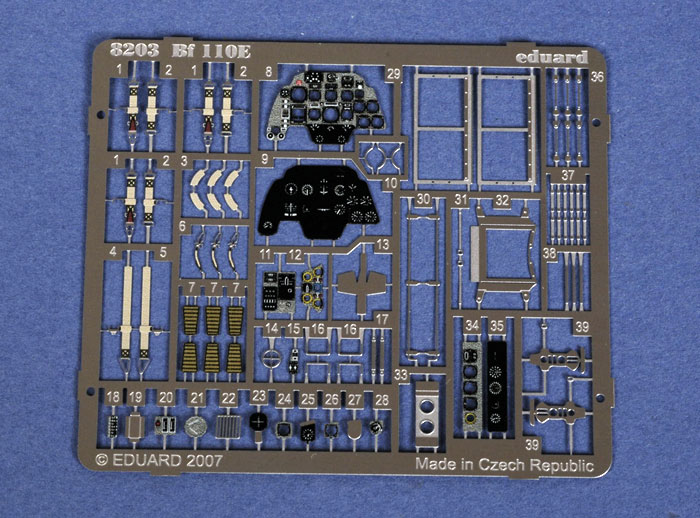
The nose is fully equipped with four MG 17 machine guns and
ammunition feeds plus oxygen bottles. These may be displayed by posing
the separate gun cowl open.
The wings are moulded with the flaps and leading edge
slats in the closed position. This may disappoint some modellers, but I
did a quick check of several books and nearly half of the Bf 110s were
parked with the slats and flaps up. If you really want to drop the flaps
and/or slats, the kit engineering will make this task fairly
straightforward with the bulges behind the nacelles moulded as part of
the bottom of the kit flaps.
Ailerons are provided as separate parts.
Wheel well detail is excellent.

The engine nacelles are supplied separate from the
wings, suggesting that we may be in store for different variants in the
future. Of particular interest, the oil cooler section at the bottom of
the nacelles are separate, so we may see the deep tropical oil cooler in
a future release, By the way, although the trop air filters are shown in
the box art, they do not appear to be included in this particular kit.
The shape of the spinners looks good, and the prominent pitch collars
are moulded near the base of each propeller blade. These should be
clearly visible when the propeller assembly is complete.
Ample options are supplied including ETC racks, 50kg and
250kg bombs. Many other options are marked as "not for use". These
include 300 litre and 900 litre drop tanks, air to air rockets and the
small 75 litre auxiliary oil tank sometimes fitted to the bottom of the
fuselage. The massive "dachshund" belly tank for the Bf 110 D is also
included.
Two sprues of clear parts are included. The prominent
glasshouse is an important part of the Bf 110's character, and Eduard
has done an especially good job on the complex rear clamshell. If the
rear canopy is to be depicted open, separate parts are supplied for the
clamshell and the sliding top rear sections. If the canopy will be
closed, a totally separate single part is used. A separate piece of
armoured glass is also depicted, with an alternate photo-etched frame if
the modeller prefers. The side and top canopy parts are also individual
pieces to permit posing in the open position. Furthermore, alternate
styles of rear canopy are offered - with the machine gun cutout and
without. Handles and other canopy details are supplied in both photo
etch and plastic. Eduard masks are also included to ease the pain of
painting that maze of canopy frames.
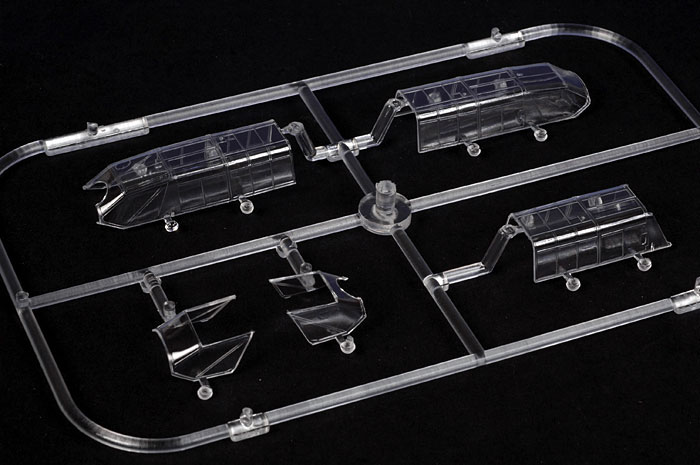
Instructions are supplied in a colour 20 page booklet,
with a historical summary on the front page followed by a parts list, 13 pages of construction steps and four pages of full-colour marking
guides, each with a four-view illustration plus scrap views.
Markings are supplied for five aircraft, all with
different schemes. Decals were not included with my early sample but I
am sure that I will be able to pick these up this week in Anaheim.
The painting instructions call out RLM 74/75/76 Greys
for most of these aircraft, but I would have expected at least some of
them to be finished in RLM 02/71/65. In fact, the box art appears to
suggest this too. The actual colours and camouflage transition on Bf
110s is far from an exact science, but it would seem that the new RLM
74/75/76 scheme was not actually applied at the factory until
March/April 1941, well after the commencement of the Bf 110 E production
run. Having been finished in RLM 02/71/65, it is unlikely that these
aircraft would have been repainted until major overhauls.
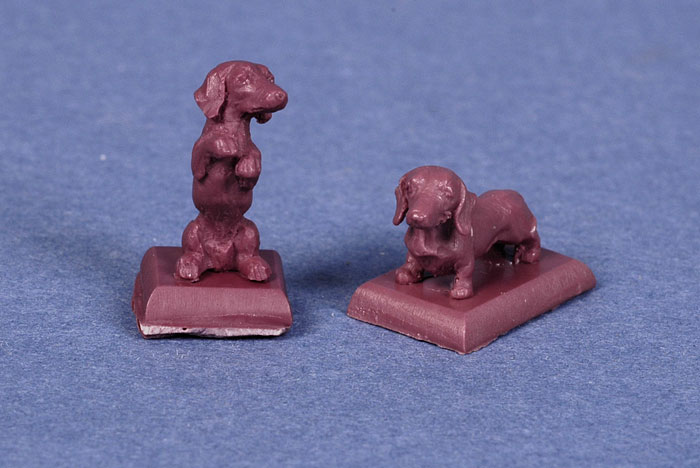
The package is topped off with two resin Dachshunds in
recognition of their association with 1.(Z)/JG 77. These are tiny but
perfectly formed!
Eduard has now relegated the old Fujimi 1/48 scale Messerschmitt Bf
110 to your favourite nephew. The new Eduard kit eclipses Fujimi's Bf
110 in every respect.
This is a beautifully presented and detailed kit. The high parts
count and some of the smaller and delicate parts mean that some
modelling experience will be helpful before tackling this project, but
there can be little doubt that Eduard's 1/48 scale kit is now the
reigning champion of plastic Messerschmitt Bf 110s of any variant and in
any scale.
I can't wait to build mine!
Highly Recommended.
Review Text Copyright © 2007 by
Brett Green
Page Created 20 August, 2007
Last updated 24 December, 2007
Back to HyperScale Main Page
Back to Reviews Page
|
Home
| What's New |
Features |
Gallery |
Reviews |
Reference |
Forum |